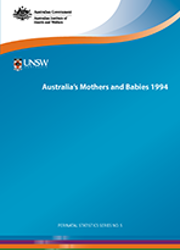Highlights
- In 1994, 261,335 babies born to 257,657 mothers were notified to perinatal data collections in the States and Territories, an increase of 0.3% from 1993. More mothers had their babies in birth centres than in previous years and home births declined slightly in 1994.
- The average age of all mothers in 1994 was 28.3 years, and 26.3 years for those having their first baby, continuing the upward trend in recent years. There were 13,732 teenage mothers (5.3% of all mothers), of whom 4,291 were aged 17 years or younger.
- Although some women are deferring childbearing, in 1994 only 1 in 15 mothers had their first baby at 35 years or older. One in 10 mothers with private health insurance were in this group, compared with only 1 in 25 mothers who did not have health insurance.
- There were 7,397 Indigenous mothers (2.9% of all mothers), of whom 2,347 gave birth in Queensland, 1,530 in New South Wales, 1,433 in Western Australia, 1,220 in the Northern Territory, and smaller numbers in the other States and the Australian Capital Territory. Their average age was 23.8 years and there was a high proportion of teenage mothers (24.6%).
- The proportion of mothers who were born in other countries decreased slightly to 22.8% in 1994, down from 23.1% in 1993. Mothers born in Asia increased from 5.1% of all mothers in 1991 to 7.0% in 1994, reflecting the increasing number of confinements of mothers born in countries such as Vietnam (4,290), China (2,661), India (1,311), and Hong Kong (1,120).
- Multiple pregnancies accounted for 1.4% of all confinements and included 3,496 twin pregnancies, 85 triplet pregnancies, and 4 quadruplet pregnancies.
- In 1994, almost 1 in 5 (19.4%) births was by caesarean section, continuing the rising trend from 18.0% in 1991, 18.3% in 1992, and 19.0% in 1993. South Australia (23.5%) had the highest caesarean rate in 1994 and Tasmania (17.2%) the lowest. Caesarean rates were higher among older mothers, those having their first baby, and those with private health insurance. Mothers aged 35-39 years who were privately insured and having their first baby had a caesarean rate of37.5%.
- More mothers had relatively short postnatal stays in hospital in 1994 than in previous years. The proportion who stayed less than 4 days increased from 20.2% in 1991 to 31.9% in 1994. Mothers without private health insurance had shorter postnatal stays than those with private health insurance.
- Low birthweight (less than 2,500g) occurred in 16,387 (6.3%) infants in 1994. The mean birthweight of infants of Indigenous mothers was 3,148g, 211g less than for all births; 12.8% of Indigenous infants had a low birthweight, just over twice the national proportion.
- Fetal, neonatal and perinatal death rates continued their downward trend of the last two decades, declining to 4.7, 3.4 and 8.0 per 1,000 births, respectively, in 1994, the lowest rates yet achieved. Early neonatal deaths and fetal deaths during labour have shown the greatest declines. The perinatal death rate of twins was 4.2 times higher, and of other multiple births 8.7 times higher, than the death rate of singleton babies.
- In 1994, the survival up to 28 days of low birthweight infants varied from 64.3% for infants of 500-999g to 94.5% for those weighing 1000-1499g, and 97.2% for infants of 1500-1999g.



